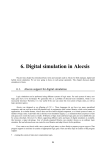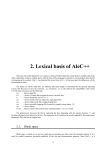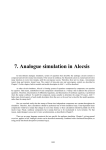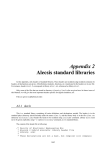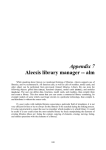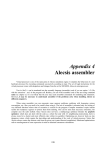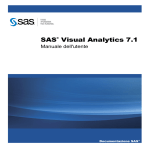Download 8. Hybrid simulation in Alecsis
Transcript
8. Hybrid simulation in Alecsis
If a circuit has both analogue and digital components, the simulation is hybrid. Analogue components are
time-continuous, and analogue links (node, flow, etc.) have real values. That means, for analogue components
system of equations is built and solved in many time-instants. Digital components are discrete-event, i.e. they are
active only in discrete time instants. That means that an event-driven simulation algorithm is used, where
propagation of events through the system is traced (no system of equations is necessary). Links in discrete-event
components (signal) usually have discrete values (usually some enumeration type). However, in Alecsis signals
can have real values (type double), too.
In hybrid simulation two kinds of coupling has to be performed:
time-synchronization of analogue and discrete-event simulator;
conversion of signals for all links with hybrid aspects.
Time-synchronization is performed by Alecsis, and user has no responsibility for it. However, second aspect
of coupling demands user attention. Converters of signals are automatically inserted by the simulator for all links
with hybrid aspect. However, Alecsis has not built-in system of states for digital (discrete-event) simulation.
Therefore, user can define his own system of states. If he does that, he have to define his own D/A and A/D
converters for that system of states, and these converters are later automatically inserted by Alecsis. For that reason,
this Chapter concentrates on this second aspect of analogue/digital coupling.
Alecsis knows in advance only the nature of built-in components -- they are analogue. Other models, that are
described in AleC++ or are already compiled in Alecsis object-code, can be analogue, digital or hybrid -- the syntax
is the same. The nature of these models, and aspect of links (analog, digital or hybrid) can be determined
only when the whole circuit description is read (the hierarchical tree, describing the circuit hierarchy is built).
The link has hybrid aspect if it is used both as analogue and as digital link. It is used as analogue if it
appears as unknown in the system of equations. It is used as digital if some processes are sensitive to it, or it is
driven by some digital driver. Between an analogue link and a component where appropriate formal signal has
141
142
Alecsis 2.3 - User’s manual
direction in or inout, Alecsis inserts A/D converter. On the other hand, Alecsis inserts D/A converter between an
analogue link and acomponent, if the component has a driver for the appropriate signal.
8.1.
Implicit converters of link aspects
Alecsis automatically inserts a converter whenever it detects a hybrid link, but it cannot determine its
structure. Converter structure depends on the system of states used for digital simulation, and of desired conversion
accuracy. Therefore, converters have to be defined by the user. (Of course, this does not mean that you have to
determine new converters for every new hybrid problem -- if you use some standard system of logic states from the
library, and appropriate standard logic gates, you normally have standard A/D and D/A converters available in the
library, too.)
Converters are just a special type of modules that user defines according to the manufacturing technology
and the desired accuracy of the conversion. These modules must have two formal signals, one with the analogue, the
other with the digital aspect. Converter cannot accept action parameters, but can accept parameters through the
model card. However, converter has not its own model card, it accepts model card from the inserted digital
component. To enable that, appropriate model class for converter has to be the same as the model class of the
inserted component, or its base class.
Converters are modules of hybrid nature, since they have:
♦
formal links of both aspects;
♦
processes with digital synchronization (sensitive to signals) and analogue, synchronized by the internal
simulator signals;
♦
analogue components declared in the structural region.
These analogue components are representing structural, or combined structrual-functional model. It is the model of
the input of the digital component (in case of A/D conversion), or output of the digital component (in case of D/A
conversion), as seen from the analogue part of the circuit. For instance, this can be only a capacitor marking input
capacitance (for digital component in CMOS technology), or the input to a TTL circuit with a bjt and additional
components. The number and the type of analogue elements depend on the technology and desired accuracy of
conversion.
8.1.1. A/D conversion
A/D converters are inserted for every hybrid link that is connecting analogue components and the component
with the appropriate formal signal having direction in or inout. A/D converter has two formal links - analogue
link and digital signal. It is usually a combination of several elements modelling the input of a digital circuit; and a
process where analogue link is compared with a series of fixed threshold, to determine state of appropriate
digital signal.
This process is always synchronized using post_moment synchronization signal. It activates only
when the analogue part of the circuit has an accepted solution for the present time-instant (analogue simulator reject
solution in a time-instant if local truncation error is greater than the appropriate tolerance, and repeats the simulation
with the shorter time-step). Using post_moment synchronization guarantees the validity of the analogue
solution for the present time-instant.
It is already stated that the conversion inside that process comes down to comparison of an analogue
quantity with a series of thresholds, which effectively converted a continuous quantity into discrete domain. The
number of thresholds depends upon the system of states the converter is defined for. The values of thresholds can be
8. Hybrid simulation in Alecsis
143
fixed, or depending upon parameters in case the converter has a model class. Usage of model class enables
modelling of inputs in different technologies.
Conversion can be direct or delayed. In the first case, the values are converted as they come (e.g., if we
have transition of a node from 0 to 5v, there is a passage through an zone in between thresholds 0 and 1 where
converter will give output state 'x'). The second method assigns the new signal only after it determines whether
the transition to 'x' state is a true undetermined state, or just transient phase 0->1 or 0<-1.
Here is an example with direct conversion:
implicit { capacitor c, C; }
typedef enum { 'x', '0', '1' } three_t;
module cmos_a2d (node analog; three_t out digital) {
capin (analog, 0) 0.1p;
action post_moment {
three_t last_state='x', new_state;
if (analog > 3.5v) new_state = '1';
else if (analog < 1.5v) new_state = '0';
else new_state = 'x';
if (last_state != new_state) {
lasr_state = new_state;
digital <- new_state;
}
}
}
This example presents a simple A/D converter intended for the connecting a hybrid link with the input of
CMOS logic gate. The new event is generated in every time-instant of analogue simulation, but only after a
threshold is reached. Assignment of signals in processes post_moment is processed in the same time-instant as
analogue simulation (keyword now returns the same time for processes per_moment and processes
post_moment, but the post_moment executes after the solution is accepted, i.e. local truncation error is small
enough). No delay is generated. The digital circuit will not notice the difference between signals from the converters
and other signals in the digital part (although you can check the predefined signal attribute hybrid to see whether
the signal originates from digital component, oris generated by the converter).
The previous example uses direct conversion. The signals from the output of a digital circuit will have short
intervals of 'x' states in the transition period. This is a 'false alarm', although some logic simulators (e.g. HILO)
have the capability for the logic circuits to generate those kinds of signals. Here is an example with delayed
conversion:
module a2d (node analog; fift_t out digital) {
capin (analog,0) 0.3p;
action {
process post_moment {
fift_t last_event='x', new_event;
double dval, last_val;
dval = analog;
if (dval >3.5) {
/* rising !! */
new_event = '1';
}
else if ( dval < 1.5 )
/* falling */
new_event = '0';
}
{
144
Alecsis 2.3 - User’s manual
else {
/* is it real 'x' or just a transition? */
if (last_event == '0' && dval < last_val
|| last_event == '1' && dval > last_val)
new_event = 'x';
}
if (last_event != new_event) {
last_event = new_event;
digital <- new_event;
}
last_val = dval;
}
}
}
This converter uses not only the value of the analogue variable, but also the sign of the slope (the sign of the
firs derivative) of the analogue curve. If the previous state was '0', the state 'x' will not be assigned
immediately when the threshold for '0' is passed. The new state is not assigned while the slope is positive, i.e.
during the transition. The same is valid if the previous state was '1'. State 'x' is not assigned when the threshold
for '1' is passed, while the slope is negative. When the first derivative changes the sign, state 'x' is assigned. In
this way, the normal transitions from one to another state do not generate 'x' state, but only fluctuations, that are
really undefined ('x') states.
Note:
Note that delayed conversion does not mean that any artificial delay is generated in the process of
conversion. For instance, when the analogue signal is rising, state '1' is assigned immediately after threshold for
'1' is passed. Name delayed means that the simulator waits to study the real behaviour of the signal during the
transition only.
Converters for systems with more logic states can have more voltage thresholds. Also, converters for circuits
with bipolar inputs need additional analogue components for correct modelling. However, the conversion procedure
does not differ.
8.1.2. D/A conversion
For every digital driver of a hybrid link, D/A conversion is necessary. As was the case with A/D converters,
compiler inserts D/A converters for appropriate digital component. That means, if we have an analogue component
connected to the bus, driven by more digital components, mechanism of digital resolution will not be applied. D/A
converters are generated for every driver, and the analogue simulator would resolve conflict on the bus.
The component with more than one driver for hybrid signal (more than one process can assign to given
signal) would be then resolved in different way: digital resolution is performed inside the component, and the
solution is converted into the analogue domain. This is usually not what is wanted, so the simulator issues warnings
in those situations. Generally, in one digital module you should avoid creation of more than one signal driver
(more than one process that assigns to one signal).
D/A converter is actually a controlled source. The analogue part of the converter should create the illusion
for the analogue subcircuit that the whole circuit consists of analogue components. Model of output of digital
component usually comprises a controlled source, output resistance, and output capacitance. These components can
be linear or nonlinear, depending on the desired conversion accuracy.
The transition of state on the digital driver is abrupt. However, it should not be modelled as abrupt change of
controlled source in a D/A converter. An abrupt change of the parameters of analogue component can create
convergence problems, and, what is even more important, is not an accurate model of real behaviour. Abrupt
changes of states in digital circuits are modelling of real circuit behaviour on the higher level of abstraction. In the
8. Hybrid simulation in Alecsis
145
analogue part, we should use more accurate modelling, on the lower level of abstraction, where all changes are
continuous. For that reason, good D/A converter ought to have two processes - one that sensitive to a digital signal,
and the other to model continuous transitions.
This transition of the analogue controlled source in a D/A converter contributes to a total delay of a digital
signal. Therefore, if the signal has attribute hybrid with value 1, the delay assigned in modelling of digital circuit
should be shortened for the transition time of the analogue source (so the total delay is correct). Beside that, delay
due to load (see Chapter 6 on digital simulation, section on user-defined attributes of signals) should not be used,
since the load is here analogue and the delay will be determined by analogue simulator. Therefore, the delay,
defined in digital processes for drivers of hybrid links, must not take into account capacitive load on the
output, and is reduced for the time needed by the controlled source of the D/A converter to reach the half of
the transition.
Here is an example of D/A converter:
enum status { Rising, Falling, Steady };
#define NewR(state) (state=='x' ? 100k : state=='z' ? 1e9 : 1k)
#define RiseTime 10ns
#define FallTime 10ns
#define NewLevel(state) (state=='1' ? 5v : state=='x' ? 2.5v : 0v)
module cmos_d2a (four_t in digital; node analog) {
resistor Rout;
capacitor Cout;
cgen Iout;
Rout (analog, 0);
Cout (analog, 0);
Iout (0, analog);
action {
four_t old_state='0', new_state='0';
status stat = Steady;
double start_value=0, end_value=0, start_time=0, end_time=0;
process (digital) {
old_state = new_state; new_state = digital;
if (new_state == 'z' && old_state == '0' ||
new_state == '0' && old_state == 'z' )
stat = Steady;
else if (old_state == '1' ||
old_state=='x' && new_state != '0')
stat = Falling;
else
stat = Rising;
if (state != Steady) {
start_value = NewLevel(old_state);
end_value = NewLevel(new_state);
start_time = now;
end_time=start_time+(stat==Falling?FallTime:RiseTime);
}
}
process per_moment {
if (stat == Steady) {
*Rout = NewR(new_state);
*Iout = end_value/(*Rout);
}
else {
if (now < end_time) {
146
Alecsis 2.3 - User’s manual
*Rout=new_value=='z'?1e9:100k;
slope=(end_value-start_value)/end_time-start_time);
*Iout = (start_value+now*slope)/(*Rout);
}
else {
*Rout = NewR(new_state);
*Iout = end_value / (*Rout);
stat = Level;
}
}
}
}
}
The concept of this D/A converter is the in the recognition of the three states, which are enumeration
constants Rising, Falling, and Steady. The process sensitive to change of the formal signal
digital controls the state of the converter, while the process per_moment controls the values of
analogue components according to the converter state. Analogue components are capacitor Cout, resistor Rout,
and current source Iout. In the Steady state, these analogue components have fixed values, according to the
last logic state. In the other two states current sources Iout changes its current according to the predefined
equation. Converter can be transferred into the Rising or Falling state only by the first process, that is
sensitive to signal digital. On the other hand, converter moves into the Steady state when the current source
Iout reaches the final value.
The analogue simulator can reject the solution and backtrack, in order to shorten time step. However, this
model is valid even if this happens (it will not backtrack beyond start_time).
We use current source Iout in parallel with resistance Rout, rather than voltage source in series with
resistance. The latter would demand two more equations (one for the internal node for the series connection with the
output resistance, and another for the current through the voltage source).
The drawback of this D/A converter model is that the model parameters are fixed. Such parameters should be
grouped into model cards, as they depend on production technology.
8.2.
Converter declaration
The simulator does not know in advance which converter models are to be used for given problem. You need
to define this explicitly, whenever you expect a hybrid simulation. Converter models are declared for digital
circuits. There are three ways of declaring converters:
−
for the whole circuit (if technology is unified), in the root module;
−
at the individual module level;
−
for particular formal signal.
8.2.1. Converter declaration for the whole circuit
Declaration of the converter for the entire circuit is in the root module, after the structural region.
8. Hybrid simulation in Alecsis
147
root module X () {
...
// declarative part
...
// structural part
conversion { a2d = cmos_a2d; d2a = cmos_d2a; }
...
// printout control, timing and options control
...
// functional part
}
You create block for declaration of modules for A/D (parameter a2d) and D/A (parameter d2a) conversion
using the key word conversion and parentheses. The names of modules can be also given together with the
names of libraries they are stored in (e.g., lib1.cmos_a2d), otherwise linker will search all libraries.
When forming a hierarchical tree, the information on converters will be recursively passed to all children
modules. The conflict with model cards will not arise if:
•
children modules do not accept model cards, or
•
the model class of the converter is the same as the model class of children module, or one of its base classes.
Converter declaration for the root module can be masked by declaration for children modules, or with
declaration for individual formal signals.
8.2.2. Converter declaration for module
You can mask the converter declaration from the root module with an identical declaration in the
current module. The new declaration applies to all submodules of that module (i.e to its children), if not
separately masked in some of them. If only one converter is declared for the module (a2d or d2a), another one
is obtained from the parent module.
Converter declaration for module can be masked by declaration for children modules, or with declaration
for individual formal signals.
8.2.3. Converter declaration for formal signals
The declaration of converters is allowed for individual formal signals. This declaration has the priority. The
of names of conversion modules are given using following syntax:
module rsff(three_t in reset:cmos_a2d, set;
three_t inout q, nq: (cmos_a2d, cmos_d2a)) {
...
}
Converters are declared after the declarator (and after an optional initializer), and apply to only one signal
(here only nq).
You can declare only one converter for formal signals with in direction (this must be A/D converter) and
only one converter for formal signals with out direction (D/A). Here, signal reset with direction in has A/D
converter declared. For inout signals, you can list both converters (in parentheses, separated by a coma, as for
signal nq).
148
Alecsis 2.3 - User’s manual
These converters are created as the children of the current module, and will be able to inherit its model
card (under the conditions that model class of converter is the same as model class of the module, or its base
class). Formal signals that do not have this declaration will inherit converters from the current module, or its parents
(signals set and q). Local signals cannot have converters in their declaration.
8.2.4. Organization of class hierarchy for digital model classes
Since converters do not take action parameters or model cards directly, the only way the make them
dependent on parameters is using the model cards of the parents. To use the same converter for digital circuits with
different functions and parameters, you should do the following:
You need to create the base class, which is accepted by the converters. It will be a common class for a
large group of digital circuits, which makes converters common, too. You can place here all parameters
that have no connections with the conversion, but are also common. To make them accessible from
derived classes, you need to declare these parameters as protected and not private.
For each type of digital circuits, that demands new, different parameters, you need to develop a new
model class by deriving it from the base class. To avoid problems iwth offset, it is important for all
derived classes to have a single class as base class.
The address of the derived model card will be the address of the base part, and so converters will be able to
find their parameters. Initialization of the base part of the card can be achieved by defining a separate constructor.
As Chapter 4 on object-oriented programming emphasizes, during a construction of a card (being a static object) the
constructors of the base class will be invoked first, and then the ones from derived classes (vice versa for
destructors). However, base preprocessors are not automatic, and should be called from the derived processor.
All parameters of the base class should have usable initial values, which makes their redefinition necessary only in
the case we want to change them.
class common {
protected:
int tech;
// basic technology
double Cin, Rin;
// impedance for A2D
double Cout, Rout;
// impedance for D2A
double zero_level, unit_level, x_level; // analog levels
double z_impedance;
// turn-off impedance
double rising_time, falling_time;
// transition times
public:
common();
>common();
friend module common_a2d, common_d2a;
};
class gate : public common {
double tplh, tphl;
double skew;
public:
gate();
>gate();
double f_delay(four_t new_state);
};
// define base constructor
common::common() {
tech = CMOS; Cin=0.1p; Rin=1e15; Cout=0.1p; Rout=1k;
8. Hybrid simulation in Alecsis
149
zero_level=0v; unit_level=5v; x_level=2.5v; z_impedance=1e9ohm;
rising_time = falling_time = 10ns;
}
// define base preprocessor
common::>common() { ... /*anything*/
}
// define derived constructor
gate :: gate () { tplh = tphl = 10ns; }
// define derived preprocessor
gate :: >gate () { common::>common(); .../* enything ELSE */ }
// define one model card
gate :: mod1 {
tplh = 3.4ns; tphl = 5.6ns;
common::rising_time = 2ns; falling_time=3ns; tech = CMOS;
}
The previous example defines class common, which stores common, mainly conversion data for a
series of digital circuits. By declaring converters common_a2d and common_d2a as friends of the class
common you enable them to access the private parameters. Setting those parameters in the constructor enables
correct conversion, even if they are not set in the model card.
You can use the derived class gate for a larger number of standard logic gates, which use parameters
tplh, tphl, and skew to model delay. Base class constructor is called before the derived class constructor
automatically, while you have to call the base preprocessor explicitly form the derived class preprocessor.
Model card mod1 of class gate can set parameters of both the base and the derived classes. You can
access base parameters with or without the operator of access resolution (::).
This way of modelling allows modelling of new groups of digital circuits 'in layers'. Notice that every change
in the base class automatically means changes in derived classes, according to the rules of object-oriented
programming.
8.3.
An example of hybrid circuit simulation
We left an example of simulation of parallel AD converter for the end of this Manual. Note that we are not
speaking here about module for conversion of link aspects, but about the circuit for conversion of analogue signal
into digital one. The ADC consisto of comparators, resistance network and combinational logic (Figure 8.1.).
150
Alecsis 2.3 - User’s manual
Combination
logic
Figure 8.1.
Parallel A/D converter as an example of hybrid circuit simulation
The circuit consists of seven CMOS opamps, which are used as comparators. Comparison etalons come from
the serial resistance network. With the increase of input voltage, the outputs of comparators, one by one, change
from the lower voltage supply level vss to the upper voltage supply level vdd, that is from 0 to 5V. The outputs
of the comparators are directly fed to combinational network. The output of this digital network is a three-digit
number. Input voltage of 0V corresponds to output 000, and 5V to 111. Every opamp has 15 MOS transistors,
and is in cascade OTA configuration. Combinational network is modelled functionally, using overloaded logic
operators. We have used libraries opamp (with amplifiers), op15 (program support for system with 15 logic
states) and alec (standard Alecsis library).
The nodes where analogue circuit and digital circuit meet are opamp outputs. These nodes are hybrid, and
implicit insertion of converter of link aspects is performed there.
The code in full follows:
#include <alec.h>
spice {
#include "omos.mod"
}
library opamp, op15, alec;
#include "ss15.h"
#include "opamp.h"
/**************************************************************/
module comp_line ( node input; node line[], udd, uss) {
module Ota opamp;
resistor r, rup, rdown;
node joint[auto];
8. Hybrid simulation in Alecsis
151
action structural (int resolution) {
int i;
node joint(resolution);
if (resolution < 2)
warning("illegal A2D converter resolution", 1);
/* clone edge resistors */
clone rup
(udd, joint [resolution-1]) Rvalue/2;
clone rdown (uss, joint [0]) Rvalue/2;
for (i=0; i<resolution; i++) {
clone opamp [i] (input, joint [i], line [i], udd, uss);
if (i<resolution-1)
clone r[i] (joint[i], joint[i+1]) Rvalue;
}
}
}
/**************************************************************/
module comb_logic4 (fift_t in line[7]; fift_t out b[3]) {
action (double delay = 10ns) {
process (line) {
three_t l0, l1, l2, l3, l4, l5, l6;
three_t l23, all, b0, b1;
l0 = Con15to3[line[0]];
l1 = Con15to3[line[1]];
l2 = Con15to3[line[2]];
l3 = Con15to3[line[3]];
l4 = Con15to3[line[4]];
l5 = Con15to3[line[5]];
l6 = Con15to3[line[6]];
all = l0 & l1 & l2 & l3 & l4 & l5 & l6;
l23 = l2 ^ l3;
b1 = (l5 ^ l6) | l23 | (l1 ^ l2) | all;
b0 = (l4 ^ l5) | l23 | (l0 ^ l1) | all;
b[0] <- tech_tab[CMOS][Con3to15[b0]] after delay;
b[1] <- tech_tab[CMOS][Con3to15[b1]] after delay;
b[2] <- tech_tab[CMOS][Con3to15[l3]] after delay;
}
}
}
/***************************************************************/
#define Period 100us
#define Resolution 7
#define VDD 5v
root parallel () {
vpwl vin;
comp_line comparator;
comb_logic4 combinatorial_logic;
vgen vdd;
fift_t line[Resolution];
fift_t b[3];
comparator (input, line, udd, 0) resolution = Resolution;
152
Alecsis 2.3 - User’s manual
combinatorial_logic (line, b);
vin (input, 0) { 0,0v; Period, VDD; };
vdd (udd, 0) VDD;
conversion { a2d = "a2d"; }
plot
{ node input; node line; signal fift_t b; }
timing { tstop = Period; a_step = Period/100; }
options { dcon=1; maxiter = 20; maxdump = 5; }
}
The results of hybrid simulation of this circuit are given in Figure 8.2. We have obtained correct conversion.
You can notice the shift in the average signal value at the input of the opamp (increase in voltage on the '-' input),
which changes its characteristics (reduces the slope), and that introduces distortion into the converter characteristics.
The whole circuit contains 105 MOS transistors. To solve it, Alecsis forms a system of 103 equations, seven
post_moment processes, and one digital process (for combinational logic).
Figure 8.2. Simulation results of parallel A/D converter in CMOS technology.












